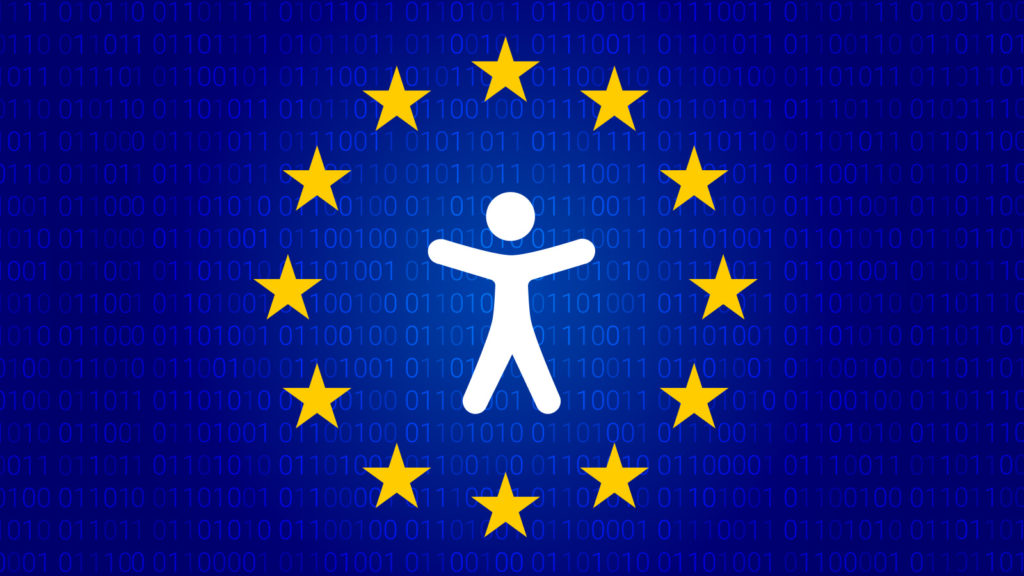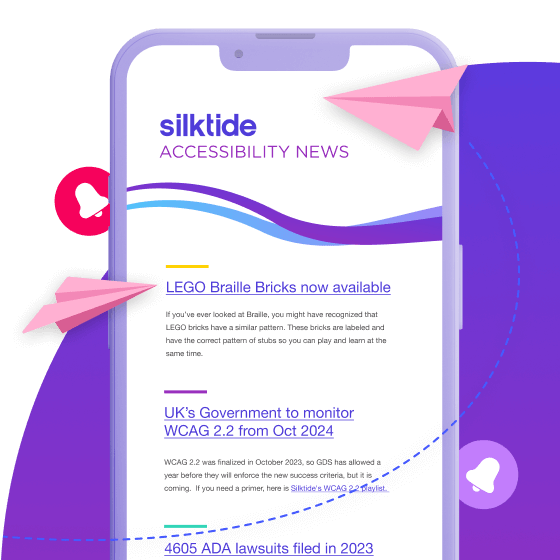The European Accessibility Act (EAA) is coming in 2025. Will we finally see improvements in private sector web accessibility?
For some years, the EU public sector has enjoyed the benefits of the EU Web Accessibility Directive – legislation that mandates publicly-funded websites in the EU to be accessible to WCAG 2.1 standards. It was implemented back in September 2020.
What’s been lacking is similar legislation aimed at EU privately-owned businesses. Until now, the private sector has avoided legislation with any teeth in terms of web accessibility. And unfortunately, it shows. We’ve already talked extensively about the disparity between web accessibility in the public and private sectors.
In short, the private sector has, on the whole, far less accessible websites than the public sector. In some sectors, shockingly so.
Two examples of the worst-performing sectors overall in the Silktide Index (our global league table for web accessibility) are grocery stores and fashion retail. This hasn’t exactly been ideal for people stuck at home for extended periods of time during a pandemic.
What is the EAA?
In summary, the European Accessibility Act aims to “harmonize accessibility requirements for certain products and services”. It aims to benefit businesses, the elderly, and people with disabilities. It also aims to clarify existing accessibility obligations in EU law.
From 28 June 2025, the following products and services will be covered by the Directive:
Products
- computers and operating systems
- payment terminals, ATMs, self-service ticket machines, and information terminals
- smartphones and other equipment for accessing telecommunications services
- TV equipment including digital television services
- e-readers
Services
- telephony services
- services to access audiovisual media services
- certain elements of air, bus, rail, and water transport services, such as websites, mobile services, electronic tickets, and information;
- consumer banking
- e-books
- e-commerce
- answering emergency calls to the “112” European emergency number
In terms of the web, the most relevant items here are e-commerce (although this is rather a broad term – more on that later) and specific references to ticketing systems and informational websites.
Importantly, the legislation will not apply to websites and other forms of archive material not updated or edited after 28 June 2025. Nor will it apply to pre-recorded videos published before that date.
The specific accessibility requirements for services include:
- providing information about the service, its accessibility features, and facilities
- making websites and mobile devices easily accessible
- applying practice and policies to address the needs of people with disabilities
What does this mean?
The specific wording of the legislation is available here but it’s a bit involved. I’ll try and summarize the relevant points as they refer to websites.
Audiovisual services
These include websites, web apps, smart TV apps, mobile apps, and related media players and connected TV services.
The Act specifically states that these examples must allow users with disabilities to access them using assistive technologies.
Travel
Real-time travel information must be accessible for rail, air, bus, and water transportation services. This includes information through websites, mobile services and interactive screens, and information terminals.
Important information including pre-journey information, timetables, cancellation and delay notifications, and the available products and services should all be accessible.
The Directive also includes the websites and mobile apps of operators in these sectors. The Index already includes rail operator websites. We’ll expand it in the future to cover other transportation sectors.
E-commerce websites of travel operators are already covered under the EU Web Accessibility Directive – specifically in the sale of tickets for such services online.
Finance
Online banking websites and apps need to be accessible under the EEA. However, there aren’t any specifics on exactly how yet. The wording is (emphasis mine) ‘this Directive should establish common accessibility requirements for certain banking and financial services provided to consumers’.
So while they should establish the requirements, it doesn’t look like they have yet.
Ecommerce
Ok, here’s the big one. When I was researching this post and read “e-commerce” my initial thoughts were, “I hope they don’t just limit this to the travel sector” – mainly because that wouldn’t go far enough.
But it turns out that “e-commerce” does indeed cover all online transactions in the EU. This is, frankly, huge news. Here’s the wording (emphasis mine):
“The e-commerce services accessibility obligations of this Directive should apply to the online sale of any product or service and should therefore also apply to the sale of a product or service covered in its own right under this Directive.”
So, my understanding of this (and I Am Not A Lawyer) is that all e-commerce transactions in the EU will be covered, along with those products and services covered in this Directive.
Now, there are some exclusions. SME’s and other small enterprises should be exempted based on ‘disproportional burden’ – that is, the cost to small businesses of implementing everything in the Directive should not be too high compared to their profitability.
In fact, SMEs and Microenterprises are protected under the Directive, which has adopted a “think small first” principle. You can read more about that in paragraph 64.
What are the accessibility requirements?
Annex I of the Directive contains a very long list of requirements for the products and services covered.
In summary, the products and services need to be designed with the four accessibility principles in mind (perceivable, operable, understandable, robust).
Information should be made available via more than one sensory channel. A good example of this would be something like adding audio descriptions to videos or adding alternative text to images.
Some of the wording is a little vague. For example, in reference to banking services and e-commerce respectively:
- “providing identification methods, electronic signatures, security, and payment services which are perceivable, operable, understandable and robust”
- “ensuring the accessibility of the functionality for identification, security, and payment when delivered as part of a service instead of a product by making it perceivable, operable, understandable and robust”
That said, examples of solutions to common problems are given in Annex II, which is useful. For example:
- “Making the identification dialogues on a screen readable by screen readers so that blind persons can use them.”
- “Making the payment service user interface available by voice so that blind persons can make online purchases independently.”
What about the Web Content Accessibility Guidelines (WCAG)?
WCAG isn’t mentioned anywhere in the Directive. If you don’t know what WCAG is, here’s a 30-second video that explains it.
Video Transcript
Jessica, voice over:
Wuh-cag, W-cag, W-C-A-G… The way you say it varies, but the rules are universal. Did I say rules? They’re actually guidelines. Insert a witty pirate joke here.
Visual:
A written screenplay of the video we’re watching. Barbosa from Pirates of the Caribbean crosses out rules with a red marker pen and writes guidelines instead.
Jessica:
The Web Content Accessibility Guidelines are a list of rules- just go with it -for making the web available to everyone. This may seem daunting at first, but I’m going to walk you through it.
You often hear or see things like “You must be compliant with WCAG 2.1” What does that even mean? Let’s break it down a little.
WCAG has a standard like 1.0 or 2.1, and a level that’s A, AA, or AAA. At Silktide, we like to say that A is must do, AA should do, and AAA is… reaching for the stars.
So when the legal requirement is WCAG 2.1 AA, it means it’s using the latest standard (2.1) and level AA (the middle one). AA is tougher to master, but still well within the reality of the web today.
All the guidelines are numbered, like 1.4.1 Use of Color. This is a single A requirement and it covers a fair bit of ground. Inside that guideline are success criteria. One such criterion is “Links must be distinguished by more than just color”. We have a video on that topic in this series! But it also covers things like not using color for instructions, like “Red fields are required” or making visuals like pie charts with no labels or patterns to discern the segments.
See, that wasn’t so bad, was it? Now go tell your friends!
Visual:
A generic character, as basic as a stick figure, wraps their arms around two other figures, drawing them closer. The middle one says happily “Let me tell you guys about WCAG!” The other two look uncomfortable.
Jessica:
Everyone deserves access to the internet if you need help getting your website up to scratch, visit silktide.com
Why’s that important? Well, WCAG (as you’ll now know if you watched the video) is a set of standards that aims to actually list out all the specific things you should do to make your website more accessible.
It’s a pretty good starting point for most websites, and in fact, the EU Web Accessibility Directive, aimed at the public sector, states that WCAG 2.1 Level AA is where you should aim.
Now, the EAA doesn’t mention this specifically for any of the products or services it covers, but it’s probably a wise idea to aim for the same standards while they decide.
If you want to, you can read through all the WCAG 2.1 guidelines here.
The first thing you’ll notice if you click that link is that WCAG is hard. Really hard. It’s not written in a particularly user-friendly way, and even the web developers who it’s aimed at have difficulty understanding its nuance.
[Editors note: Since this article was first published, we re-wrote WCAG to make it easier to understand]
What’s the solution to an inaccessible website?
There are two areas of responsibility when it comes to website accessibility.
- content – usually added by individual contributors across multiple teams, like the marketing and communications team
- the theme and underlying code – usually built and maintained by your developers
I wrote an article about who is responsible for web accessibility (spoiler alert – it’s everybody).
What are the next steps for EU business owners?
So, you have a couple of years before you have to do anything, right? Well, technically, yes. But the ROI of good web accessibility is real, and the sooner you start making your website better, the more income you’ll make and the better you’ll help people access your website.
Also, if you currently know nothing about accessibility (and this is way more common than you might think, so you’re not alone), you’ll need time to consider your options.
First, write an accessibility statement. This should outline your commitment to accessibility and list the areas that you need to improve, and also the steps you’re taking to improve.
Second, check your site for accessibility problems. Obviously, we can help you with that here at Silktide.
Third, consider downloading our free book on accessibility because it gives you a good introduction to what accessibility is and who it affects. It also includes real-world data outlining the top issues we find with our web accessibility testing platform.
It’s aimed at beginners, and you can download the free accessibility book here.
Finally, don’t be overwhelmed. The public sector got through this a couple of years ago, and in fact, they now excel in web accessibility. UK Local and Central Government, for example, rank at the top of all global websites for accessibility. The improvements made during 2020 running up to the EU Web Accessibility Directive deadline were phenomenal, and you can do it too.

